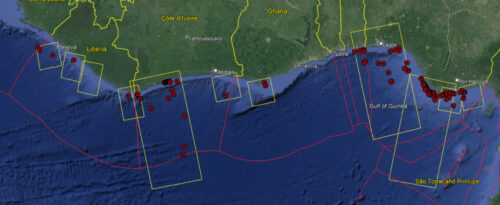 Global Fishing Watch recently met with port authorities and offered training on its commercial fishing activity platform in three important Peruvian fishing ports (Paita, Chimbote and Callao). Fisheries Analyst, Eloy Aroni, describes in this blog post how these meetings were an opportunity to discuss data and technology solutions to the main issues affecting each port, from the monitoring of national and foreign vessels to cases of illegal fishing. En Español on Oceana Peru’s site.
Global Fishing Watch recently met with port authorities and offered training on its commercial fishing activity platform in three important Peruvian fishing ports (Paita, Chimbote and Callao). Fisheries Analyst, Eloy Aroni, describes in this blog post how these meetings were an opportunity to discuss data and technology solutions to the main issues affecting each port, from the monitoring of national and foreign vessels to cases of illegal fishing. En Español on Oceana Peru’s site.
Global Fishing Watch’s latest training program began on June 27th in the fishing port of Paita on Peru’s North Coast, a port known for the highest landings of tuna by the foreign fleet. We then moved south to Chimbote, a port with the largest influx of Chinese flagged squid vessels (on average one vessel per day during the giant squid, Dosidicus gigas, fishing season). We completed the series of training workshops in Callao (port of Lima) on July 12th. Issues discussed included the illegal traffic of shark fins, catch transshipment at sea, entry of foreign vessels, illegal fishing activities, and even the smuggling of drugs by sea. The event was attended by personnel from the Peruvian customs authority (SUNAT), inspectors of the Ministry of Production (PRODUCE), Port Captaincy (DICAPI) and the Specialized Environmental Inspection Office (FEMA). These are the institutions responsible for monitoring and inspections related to fishing activity and entry of foreign vessels into Peruvian ports.

During the Global Fishing Watch training workshop, participants were taught to search for individual vessels, interpret their tracks, and identify their fishing areas. Performing filters by country for fishing activity was very useful for Customs personnel, who monitor the entry of any type of cargo from foreign vessels. Also, participants were interested in learning about the nightlight vessel detection layer to monitor the Chinese squid fleet. This layer allows you to see the fleet’s fishing activity even when vessels don’t have AIS, or intentionally turn it off, based solely on detecting the powerful lights used by the vessels to attract squid to the surface.
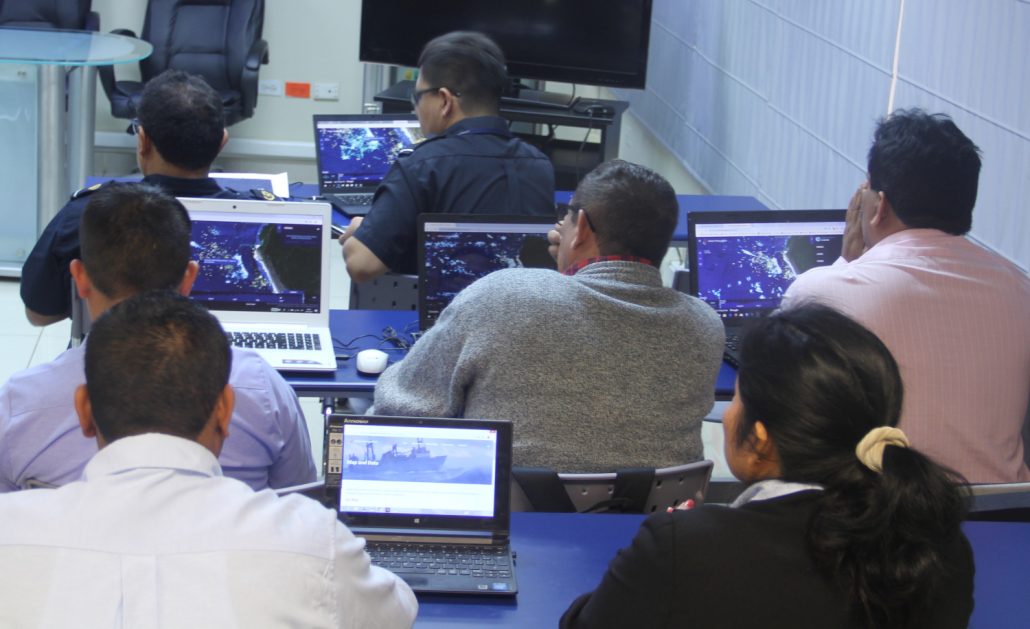
Staff of IMARPE, Peru’s marine research institute, work with observers collecting data throughout Peru’s fishing fleet and were interested in tools to filter Peruvian VMS data by fishing gear type and to upload their own data to the Global Fishing Watch map. Our vessel encounter data displaying meetings at sea between fishing vessels and reefers (refrigerated cargo ships) helped participants to understand the logistics of fishing fleets operating at sea, in particular the large Chinese squid fleet. Participants were intrigued by new methods for monitoring this Chinese fleet at the limit of Peru’s Exclusive Economic Zone (EEZ) and investigating links to illegal fishing activities.
Monitoring the foreign tuna fleet within Peruvian waters
The Peruvian national tuna fleet has only 16 vessels and an overall quota of just 8,195 metric tons within the area regulated by the Inter-American Tropical Tuna Commission (IATTC). In comparison, Ecuador has a quota of 92,184 metric tons for a fleet of 115 vessels. Because tuna concentrate within Peru’s EEZ between January and April, and Peru does not have a large tuna fishing fleet, Peru grants temporary fishing permits to foreign vessels to catch tuna within the Peruvian EEZ. Fishing permits require them to land 30% of their catch caught under the temporary permit in a Peruvian port. Vessels are also required to comply with the use of fishing gear specified in Peruvian Regulations. Additionally these vessels are prohibited from fishing within 10 miles of the coast. Authorities in Peru’s fishing ports are responsible for monitoring that the foreign tuna fleet complies with all of these conditions.
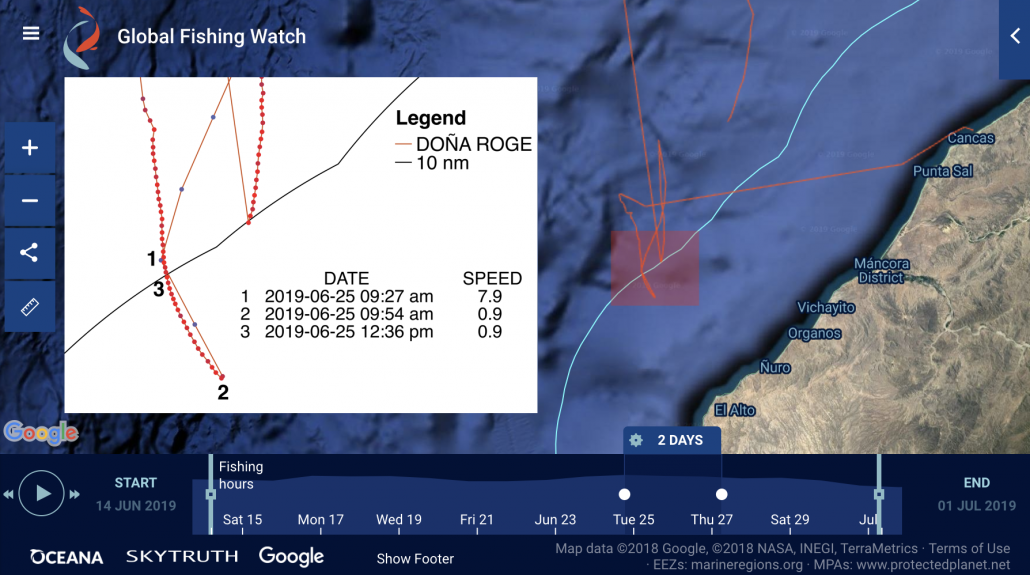 Ecuadorian tuna vessel DOÑA ROGE 8 showing likely illegal fishing activity within 10 miles of coastline. Click on link.
Ecuadorian tuna vessel DOÑA ROGE 8 showing likely illegal fishing activity within 10 miles of coastline. Click on link.
The training workshop in Paita, where most of the foreign tuna fleet offloads their catch, emphasized the use of the Global Fishing Watch map for monitoring and control of fishing activity by the authorities. We considered the recent case of the DOÑA ROGE, an Ecuadorian flagged vessel that fished illegally on June 25, 2019 inside the 10 mile limit (Figure 2). Peruvian authorities intervened and seized 268 tons of tuna caught illegally. Peruvian port authorities must monitor and regulate between 60 and 80 foreign flagged vessels (primarily from Ecuador, Panama, and Mexico) annually. For the authorities responsible for monitoring this foreign fishing fleet Global Fishing Watch has proven to be an effective open access platform for ensuring that foreign tuna vessels are complying with Peruvian regulations.
Chimbote: one of the main ports of the Chinese squid fleet in the Pacific Ocean
A squid fleet of 352 Chinese vessels according to the South Pacific Regional Fisheries Management Organization (SPRFMO) catch jumbo flying squid (Dosidicus gigas) in the Southeast Pacific and Argentine squid (Illex argentinus) in the South Atlantic. Around South America, the port of Montevideo in Uruguay and the ports of Chimbote and Callao in Peru are the main points for refueling, maintenance, and change of crew of the Chinese squid fleet. In Peru it is critical to monitor and control the entry of Chinese ships into Peruvian ports because this Chinese squid fleet has been involved in cases of illegal fishing in Argentine waters and recently within the Peruvian EEZ. Global Fishing Watch provides a platform for public monitoring of fleets like the Chinese squid fleet when Peruvian authorities in Chimbote want to ensure that IUU fishing activity has not taken place prior to a vessel entering port.
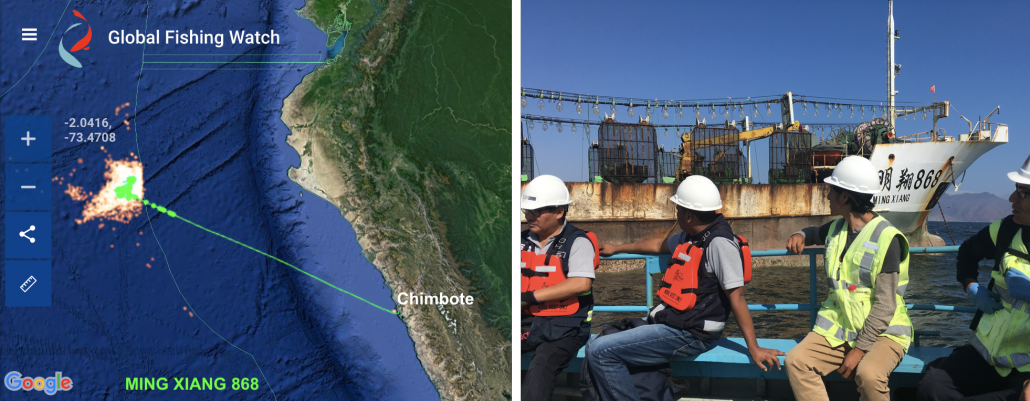 Chinese MING XIANG 868 squid boat entering Chimbote Port (right). Global Fishing Watch with the Peruvian authorities boarding the vessel for inspection (left). Click on link.
Chinese MING XIANG 868 squid boat entering Chimbote Port (right). Global Fishing Watch with the Peruvian authorities boarding the vessel for inspection (left). Click on link.
Training of Peruvian authorities in Chimbote was focused on the use of the Global Fishing Watch map to identify where the Chinese squid fleet is operating along the edge of Peru’s EEZ. We discussed the use of the GFW map to identify Chinese vessels fishing along the EEZ, transshipment activities, and vessel entry into port. We also went over ways to identify suspicious activity by Chinese ships, such as intentionally shutting down their AIS system. Global Fishing Watch also accompanied port authorities in an on board inspection of the Chinese vessel MING XIANG 868. The map showed great utility for inspectors by displaying the history of the vessel, points of fishing activity, likely transshipment events, and gaps in the AIS data. This detailed information on the vessel’s prior activities allow government officials to ask the right questions of vessel operators and verify what is reported.
Port of Callao: fighting illegal shark fin trafficking
Peru is one of the main shark fishing countries in the world, and the only exporter of shark fins from the South Pacific. The great demand for shark fins in Asian countries generates a whole network for trafficking and “laundering” of shark fins exported through the port of Callao. In port, shark fins are collected from three sources – by land from the Ecuadorian tuna and longline fleets, captured directly or as bycatch by the Peruvian artisanal fleet, and captured as bycatch by the Japanese and Spanish tuna fleet. Therefore, the Peruvian authorities are constantly working to confirm that shark fins were caught legally and this means attempting to trace the fins to where fishing actually took place.
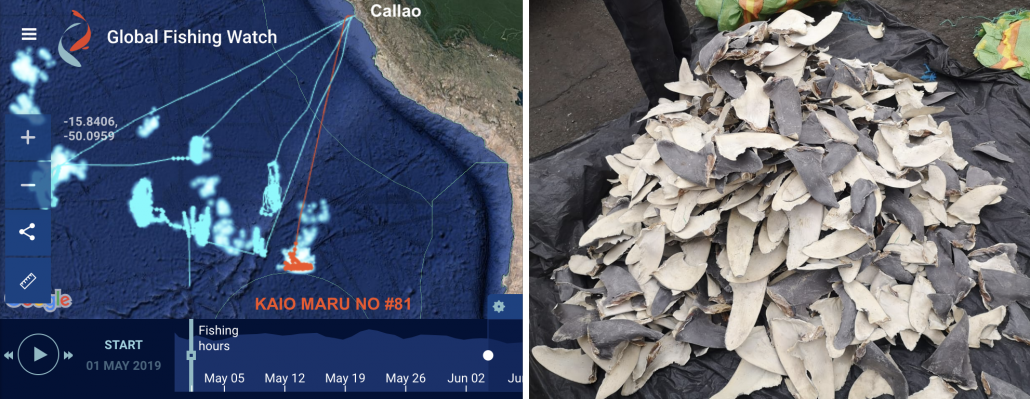 Japanese and Spanish flag tuna vessels entering the port of Callao to land shark as a bycatch, ship KAIO MARU NO.81 (orange). Click on link.
Japanese and Spanish flag tuna vessels entering the port of Callao to land shark as a bycatch, ship KAIO MARU NO.81 (orange). Click on link.
Peruvian authorities are using the Global Fishing Watch map to compare with what vessel operators report about the origin of sharks. A specific example is the case of the Japanese ship KAIO MARU No. 81 that arrived at the port of Callao with 26 tons of shark. For this cargo to enter Peru Customs authorities have to inspect the vessel to determine if species protected by CITES are present and to confirm the area where the catch came from. Global Fishing Watch is able to directly support Peruvian Customs with reports that track the fishing activity of each vessel in order to together combat illegal shark fin trafficking.
Global Fishing Watch seeks to promote sustainability and sound management of the oceans through greater transparency, offering free satellite tracking data on commercial fishing activity worldwide. We work hand-in-hand with the governments of coastal countries to combine our data with government satellite monitoring systems and publish this data on our platform with the aim of strengthening monitoring and control to combat illegal, unreported and unregulated fishing (IUU). Our visits to Peru’s three main fishing ports were a chance to see this collaboration take shape as we work closely with Peruvian authorities to address the main problems in the fisheries sector.
